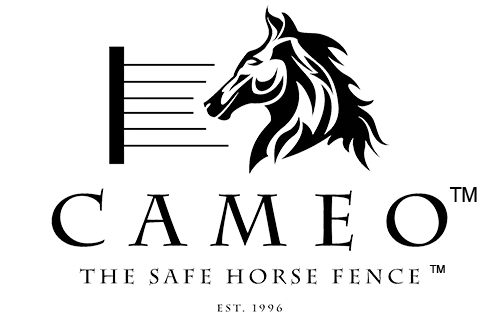Ask any seasoned rancher or equestrian and you’ll hear it: “I need a heavy-duty fence. Stronger equals safer.” But here’s the truth—when it comes to horse fence safety, strength alone can be deceiving. A rigid, reinforced structure may sound protective, but for a 1,200 lb prey animal capable of bolting at 30 mph, inflexibility can be deadly.
Cameo™ Horse Fence is engineered on a different philosophy: safety comes from flexibility, visibility, and forgiveness—not brute force.
The Dangerous Logic Behind the “Stronger = Safer” Myth
Where This Myth Comes From
Traditionally, fencing was built to contain cattle or predators, not skittish, high-energy equines. Ranchers defaulted to steel, barbed wire, or heavy wood because:
-
It looked tough
-
It was durable (at least initially)
-
It deterred breakouts in herd animals
Unfortunately, those same materials can be catastrophic for horses.
What Makes Horses Different?
-
Flight animals by instinct
-
Easily startled, especially in new environments
-
Thin-skinned and long-limbed, vulnerable to lacerations and breaks
-
Require visible, safe, and forgiving boundaries
In short, horses don’t bounce off things—they crash, twist, and tangle. Which is why rigid fencing (no matter how strong) can backfire.
Common “Strong” Fencing Options And Their Safety Flaws
1. Wood Rail Fencing
-
Splinters under pressure
-
Rots and warps over time
-
Requires frequent repairs
-
Looks beautiful but is dangerously unforgiving on impact
2. Steel Pipe or Wire
-
Zero flex = maximum force on the horse
-
Breaks bones and causes deep lacerations
-
Difficult to repair
-
Not ideal for snowy or wet conditions
3. Woven Wire or Mesh
-
Horses can get hooves caught
-
Sagging can lead to escape
-
Easy to climb or lean on
❌ These may hold in cattle, but they don’t protect your horses.
Cameo™ Fence: Designed for Horse Fence Safety
Cameo™ Horse Fence isn’t just a replacement. It’s a rethink from the ground up. We engineered it specifically around equine safety with:
✅ Key Safety Benefits
-
1200 lb Break Strength: Contain confidently without risking entanglement
-
Metal-Free Monofilament Line: No sharp wires, no rust, no electricity required
-
Elastic Polymer Flexibility: Fence gives way under pressure, then returns to form
-
High Visibility: Bright white line is easy for horses to see and respect
Visualizing the Safety Difference
| Feature | Traditional Fencing | Cameo™ Horse Fence |
|---|---|---|
| Material Flexibility | Rigid | Elastic, Impact-Absorbing |
| Injury Risk | High (Lacerations, Breaks) | Low (No Sharp Edges) |
| Visibility | Often Poor | High Contrast, Always Seen |
| Maintenance Needs | High | Low |
| Installation Difficulty | Contractor Needed | DIY-Friendly |
Real-World Safety Stories
“My gelding spooked when a deer jumped the trail. He ran straight into the fence and bounced back with no injury. I checked the line—still tensioned. Unreal.”
— Jessica T., Kentucky
“A tree fell across our pasture during a storm. The Cameo fence flexed under the weight. We pulled the limb off and everything snapped back. No broken rails. No damage to our mare.”
— Ranch Owner, Northern Georgia
Expert Opinions on Equine Fencing
According to the American Association of Equine Practitioners (AAEP):
“The safest fences are visible, forgiving, and free of sharp projections.”
— AAEP Equine Facility Safety Guidelines
Translation? Cameo’s polymer line checks all those boxes—whereas “strong” materials like barbed wire and wood fail miserably.
Still Think Heavy = Safe? Consider This
Vet Bill Comparison:
| Injury Type | Fence Type | Estimated Cost |
|---|---|---|
| Deep laceration | Barbed wire | $1,000–$2,500 |
| Broken cannon bone | Steel pipe | $3,000–$10,000+ |
| Tendon injury | Wood splinter | $1,500–$3,500 |
| No injury (flexible) | Cameo™ | $0 |
⚠️ Don’t just price the fence. Price the consequences.
Top 7 Reasons Cameo™ Outperforms “Stronger” Fences
-
Reduces serious injuries from impacts or entanglements
-
Weatherproof in snow, wind, and rain
-
DIY-installable with minimal tools
-
Maintenance-free — no painting, sanding, or resealing
-
Backed by horse owners nationwide
-
Budget-friendly upfront and long-term
-
Elegantly blends with your landscape
FAQs: Is Flexible Fencing Really Strong Enough?
Q: Will it hold up to a charging horse?
A: Yes. The line has a 1200 lb break strength—more than enough to contain without harming.
Q: What if it sags over time?
A: Properly tensioned Cameo Fence maintains its line. If needed, quick re-tensioning is simple with a gripple tool.
Q: Can I electrify it for extra security?
A: Absolutely. Cameo Fence can be optionally electrified, but it’s fully effective on its own too.
Q: Is Cameo 100% Safe?
A: We back our fence as the safest horse fence on the market but remember, No horse fence is 100% injury free.

